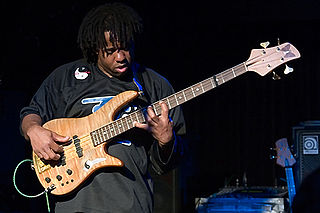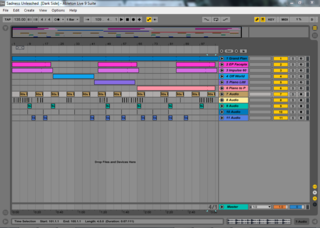
In music theory, counterpoint is the relationship of two or more simultaneous musical lines that are harmonically interdependent yet independent in rhythm and melodic contour. The term originates from the Latin punctus contra punctum meaning "point against point", i.e. "note against note". John Rahn describes counterpoint as follows:
It is hard to write a beautiful song. It is harder to write several individually beautiful songs that, when sung simultaneously, sound as a more beautiful polyphonic whole. The internal structures that create each of the voices separately must contribute to the emergent structure of the polyphony, which in turn must reinforce and comment on the structures of the individual voices. The way that is accomplished in detail is ... 'counterpoint'.

Orchestration is the study or practice of writing music for an orchestra or of adapting music composed for another medium for an orchestra. Also called "instrumentation", orchestration is the assignment of different instruments to play the different parts of a musical work. For example, a work for solo piano could be adapted and orchestrated so that an orchestra could perform the piece, or a concert band piece could be orchestrated for a symphony orchestra.
Sheet music is a handwritten or printed form of musical notation that uses musical symbols to indicate the pitches, rhythms, or chords of a song or instrumental musical piece. Like its analogs – printed books or pamphlets in English, Arabic, or other languages – the medium of sheet music typically is paper. However, access to musical notation since the 1980s has included the presentation of musical notation on computer screens and the development of scorewriter computer programs that can notate a song or piece electronically, and, in some cases, "play back" the notated music using a synthesizer or virtual instruments.
Music information retrieval (MIR) is the interdisciplinary science of retrieving information from music. Those involved in MIR may have a background in academic musicology, psychoacoustics, psychology, signal processing, informatics, machine learning, optical music recognition, computational intelligence, or some combination of these.

Bassline is the term used in many styles of music, such as blues, jazz, funk, dub and electronic, traditional, and classical music, for the low-pitched instrumental part or line played by a rhythm section instrument such as the electric bass, double bass, cello, tuba or keyboard.
A scorewriter, or music notation program is software for creating, editing and printing sheet music. A scorewriter is to music notation what a word processor is to text, in that they typically provide flexible editing and automatic layout, and produce high-quality printed results.

A digital audio workstation is an electronic device or application software used for recording, editing and producing audio files. DAWs come in a wide variety of configurations from a single software program on a laptop, to an integrated stand-alone unit, all the way to a highly complex configuration of numerous components controlled by a central computer. Regardless of configuration, modern DAWs have a central interface that allows the user to alter and mix multiple recordings and tracks into a final produced piece.

Ableton Live, also known as Live or sometimes colloquially as "Ableton", is a digital audio workstation for macOS and Windows developed by the German company Ableton.
capella is a musical notation program or scorewriter developed by the German company capella-software AG, running on Microsoft Windows or corresponding emulators in other operating systems, like Wine on Linux and others on Apple Macintosh. Capella requires to be activated after a trial period of 30 days. The publisher writes the name in lower case letters only. The program was initially created by Hartmut Ring, and is now maintained and developed by Bernd Jungmann.

In music, transcription is the practice of notating a piece or a sound which was previously unnotated and/or unpopular as a written music, for example, a jazz improvisation or a video game soundtrack. When a musician is tasked with creating sheet music from a recording and they write down the notes that make up the piece in music notation, it is said that they created a musical transcription of that recording. Transcription may also mean rewriting a piece of music, either solo or ensemble, for another instrument or other instruments than which it was originally intended. The Beethoven Symphonies transcribed for solo piano by Franz Liszt are an example. Transcription in this sense is sometimes called arrangement, although strictly speaking transcriptions are faithful adaptations, whereas arrangements change significant aspects of the original piece.
Band-in-a-Box is a music creation software package for Windows and macOS produced by PG Music Incorporated, founded in 1988 in Victoria, British Columbia. The software enables a user to create any song and have it played by professional musicians playing real instruments. It does this by accessing a large database of real musicians' recordings that can be manipulated to fit any user's song. The user enters four basic keyboard inputs consisting of: chords; a key; a tempo; a musical style. The screen resembles a blank page of music onto which the user enters the names of chords using standard chord notation. The software generates a song typically played by four or five studio musicians to fit those specified parameters. The developers have enlisted musicians as supporting instrumentalists to build huge databases of phrases in many styles of music. The software retrieves and customizes groups of musical phrases that are appropriate for soloing or comping over a particular chord at a chosen key, genre and tempo. It can create backgrounds, melodies or solos for almost any chord progressions used in Western popular music, and can play them in any of thousands of different music styles.

Tod Machover, is a composer and an innovator in the application of technology in music. He is the son of Wilma Machover, a pianist and Carl Machover, a computer scientist.

Mozart the music processor is a proprietary WYSIWYG scorewriter program for Microsoft Windows. It is used to create and edit Western musical notation to create and print sheet music, and to play it via MIDI.
JFugue is an open source programming library that allows one to program music in the Java programming language without the complexities of MIDI. It was first released in 2002 by David Koelle. Version 2 was released under a proprietary license. Versions 3 and 4 were released under the LGPL-2.1-or-later license. The current version, JFugue 5.0, was released in March 2015, under the Apache-2.0 license. Brian Eubanks has described JFugue as "useful for applications that need a quick and easy way to play music or to generate MIDI files."
Pyotr Ilyich Tchaikovsky composed his Orchestral Suite No. 2 in C major, Op. 53, in 1883. It was premiered on February 16, 1884 at a Russian Musical Society concert in Moscow, conducted by Max Erdmannsdörfer. The piece was well enough received to be repeated a week later. It is dedicated to his brother Anatoly's wife, Praskovya Vladimirovna Tchaikovskaya.

Overture is a music notation (scorewriter) program for Windows and Macintosh platforms, published and developed by Sonic Scores. While Overture is primarily a scorewriter program, it also allows editing the score's MIDI audio playback data in the manner of sequencer and digital audio workstation (DAW) software.

Pyotr Ilyich Tchaikovsky struggled with sonata form, the primary Western principle for building large-scale musical structures since the middle of the 18th century. Traditional Russian treatment of melody, harmony and structure actually worked against sonata form's modus operandi of movement, growth and development. Russian music—the Russian creative mentality as a whole, in fact—functioned on the principle of stasis. Russian novels, plays and operas were written as collections of self-contained tableaux, with the plots proceeding from one set-piece to the next. Russian folk music operated along the same lines, with songs comprised as a series of self-contained melodic units repeated continually. Compared to this mindset, the precepts of sonata form probably seemed as alien as if they had arrived from the moon.
Traditional sub-Saharan African harmony is a music theory of harmony in sub-Saharan African music based on the principles of homophonic parallelism, homophonic polyphony, counter-melody and ostinato-variation. Polyphony is common in African music and heterophony is a common technique as well. Although these principles of traditional African music are of Pan-African validity, the degree to which they are used in one area over another varies. Specific techniques that used to generate harmony in Africa are the "span process", "pedal notes", "rhythmic harmony", "harmony by imitation", and "scalar clusters".

AudioCubes are a collection of wireless intelligent light-emitting objects, capable of detecting each other's location, orientation, and user gestures. They were created by Bert Schiettecatte as electronic musical instruments for use by musicians in live performance, sound design, musical composition, and for creating interactive applications in max/msp, pd and C++.

Fugue Machine is a music sequencer created by San Francisco composer and software developer Alexander Randon, also known by his stage name as Alexandernaut. Marketed as the "world’s first multi-playhead piano roll," Fugue Machine allows the user to sequence a melody and have up to three variations of it play all at the same time. The application was originally released on October 8, 2015 for iOS, and quickly garnered notability for its intuitive methods of making complex pieces and for being the first app to be developed from the "Cultural Incubator" program by the Gray Area Foundation for the Arts.











